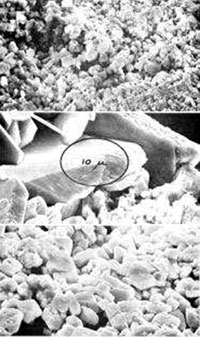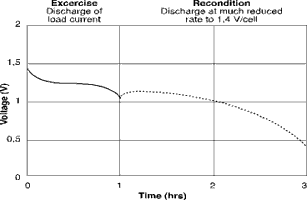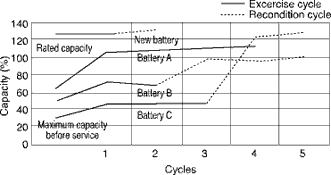
The word ‘memory’ was originally derived from ‘cyclic memory’; meaning that a nickel-cadmium battery could remember how much energy was drawn on preceding discharges. On a longer than scheduled discharge, the voltage would rapidly drop and the battery would lose power. Improvements in battery technology have virtually eliminated this phenomenon. This article by Isidor Buchmann explains a bit about looking after and protecting your battery investment.
The problem with nickel-cadmium (NiCd) is not the cyclic memory but the effects of crystalline formation. The active cadmium material is present in finely divided crystals. In a good cell, these crystals remain small, obtaining maximum surface area. When the memory phenomenon occurs, the crystals grow and drastically reduce the surface area. The result is a voltage depression, which leads to a loss of capacity. In advanced stages, the sharp edges of the crystals may grow through the separator, causing high self-discharge or an electrical short.
Another form of memory that occurs on some NiCd cells is the formation of an inter-metallic compound of nickel and cadmium, which ties up some of the needed cadmium and creates extra resistance in the cell. Reconditioning by deep discharge helps to break up this compound and reverses the capacity loss.
The memory phenomenon can be explained in layman's terms as expressed by Duracell: 'The voltage drop occurs because only a portion of the active materials in the cells is discharged and recharged during shallow or partial discharging. The active materials that have not been cycled change in physical characteristics and increase in resistance. Subsequent full discharge/charge cycling will restore the active materials to their original state.'
When nickel metal hydride (NiMH) was first introduced there was much publicity about its memory-free status. Today, it is known that this chemistry also suffers from memory, but to a lesser extent than the NiCd. The positive nickel plate, a metal that is shared by both chemistries, is responsible for the crystalline formation.
In addition to the crystal-forming activity on the positive plate, the NiCd also develops crystals on the negative cadmium plate. Because both plates are affected by crystalline formation, the NiCd requires more frequent discharge cycles than the NiMH. This is a non-scientific explanation of why the NiCd is more prone to memory than the NiMH.
The stages of crystalline formation of a NiCd battery are illustrated in Figure 1. The enlargements show the negative cadmium plate in normal crystal structure of a new cell, crystalline formation after use (or abuse) and restoration.

How to restore and prolong nickel-based batteries
The effects of crystalline formation are most pronounced if a nickel-based battery is left in the charger for days, or if repeatedly recharged without a periodic full discharge. Since most applications do not use up all energy before recharge, a periodic discharge to 1 V/cell (known as exercise) is essential to prevent the buildup of crystalline formation on the cell plates. This maintenance is most critical for the NiCd battery.
All NiCd batteries in regular use and on standby mode (sitting in a charger for operational readiness) should be exercised once per month. Between these monthly exercise cycles, no further service is needed. The battery can be used with any desired user pattern without the concern of memory.
The NiMH battery is affected by memory to a lesser degree. No scientific research is available that compares NiMH with NiCd in terms of memory degradation. Neither is information on hand that suggests the optimal amount of maintenance required to obtain maximum battery life. Applying a full discharge once every three months appears right. Because of the NiMH battery's shorter cycle life, over-exercising is not recommended.
Exercise and recondition: Research has shown that if no exercise is applied to a NiCd for three months or more, the crystals ingrain themselves, making them more difficult to break up. In such a case, exercise may no longer be effective in restoring a battery and reconditioning is required.
Recondition is a slow, deep discharge that removes the remaining battery energy by draining the cells to a voltage threshold below 1 V/cell. Tests performed by the US Army have shown that a NiCd cell needs to be discharged to at least 0,6 V to effectively break up the more resistant crystalline formation. During recondition, the current must be kept low to prevent cell reversal. Figure 2 illustrates the battery voltage during a discharge to 1 V/cell, followed by the secondary discharge, known as recondition.

Figure 3 illustrates the effects of exercise and recondition. Four batteries afflicted with various degrees of memory are serviced. The batteries are first fully charged, then discharged to 1 V/cell. The resulting capacities are shown in the first column plotted on a scale of 0 to 120%. Additional discharge/charge cycles are applied and the battery capacities are plotted in the subsequent columns. The solid black line represents exercise, and the dotted line recondition. On this test, the exercise and recondition cycles are applied manually at the discretion of the research technician.

Battery 'A' responded well to exercise alone and no recondition was required. This result is typical of a battery that has been in service for only a few months or has received periodic exercise cycles. Batteries 'B' and 'C', on the other hand, required recondition (dotted line) to restore their performance. Without the recondition function, these two batteries would need to be replaced.
After service, the restored batteries were returned to full use. When examined after six months of field service, no noticeable degradation in the restored performance was visible. The regained capacity was permanent with no evidence of falling back to the previous state. Obviously, the batteries would need to be serviced on a regular basis to maintain the performance.
Applying the recondition cycle on a new battery (top line on chart) resulted in a slight capacity increase. This capacity gain is not fully understood, other than to assume that the battery improved by additional formatting. Another explanation is the presence of early memory. Since new batteries are stored with some charge, the self-discharge that occurs during storage contributes to a certain amount of crystalline formation. Exercising and reconditioning reverse this effect.
Case studies
A certain organisation continually experienced NiCd battery failure after a relatively short service time. Although the batteries performed at 100% when new, their capacity dropped to 20% and below within one year. It was discovered that their two-way radios were under-utilised; yet the batteries received a full recharge after each short field use.
After replacing the batteries, we advised the organisation to exercise the new batteries once per month by discharging them to one-volt-per cell with a subsequent recharge. The first exercise took place after the batteries had been in service for four months. At that stage, we were anxious to find out how much the batteries had deteriorated. Here is what we found:
On half of the batteries tested, the capacity loss was between 25 to 30%; on the other half, the losses were around 10 to 20%. With exercise - and some needed recondition cycles - all batteries were fully restored. Had maintenance been omitted for much longer, the probability of a full recovery would have been jeopardised.
The importance of exercising and reconditioning NiCd batteries is emphasised by a study carried out by GTE Government Systems in Virginia, USA, for the US Navy. To determine the percentage of batteries needing replacement within the first year of use, one group of batteries received charge only, another group was exercised and a third group received recondition. The batteries were used for two-way radios on the aircraft carriers USS Eisenhower with 1500 batteries and USS George Washington with 600 batteries, and the destroyer USS Ponce with 500 batteries.
With charge only (charge-and-use), the annual percentage of battery failure on the USS Eisenhower was 45% (see Table 1). When applying exercise, the failure rate was reduced to 15%. By far the best results were achieved with recondition. The failure rate dropped to 5%. Identical results were attained from the USS George Washington and the USS Ponce.

These statistics showed that the annual percentage of NiCd batteries requiring replacement when used without any maintenance decreases with exercise and recondition. The GTE report concluded that a battery analyser featuring exercise and recondition functions costing $2500 would pay for itself in less than one month on battery savings alone. The report did not address the benefits of increased system reliability, an issue that is of equal if not greater importance, especially when the safety of human lives is at stake.
Another study concerning NiCd batteries for defence applications was performed by the Dutch Army. This involved battery packs that had been in service for two to three years during the Balkan War. The Dutch Army was aware that the batteries were used under the worst possible conditions. Rather than a good daily workout, the packs were used for patrol duties lasting 2 to 3 hours per day. The rest of the time the batteries remained in the chargers for operational readiness.
After the war, the batteries were sent to the Dutch Military Headquarters and were tested with Cadex 7000 Series battery analysers. The test technician found that the capacity of some packs had dropped to as low as 30%. With the recondition function, 90% of the batteries restored themselves to full field use. The Dutch Army set the target capacity threshold for field acceptability to 80%. This setting is the pass/fail acceptance level for its batteries.
Based on the successful reconditioning results, the Dutch Army now assigns the battery maintenance duty to individual battalions. The program calls for a service once every two months. Under this regime, the Army reports reduced battery failure and prolonged service life. The performance of each battery is known at any time and any under-performing battery is removed before it causes a problem.
Summary
Each battery system has a few shortcomings: the lithium family ages and has limited load current; the NiMH has a relatively short service life; the lead acid family is bulky and requires long charge times; and the NiCd has memory. But the NiCd makes up by being the most enduring battery. In addition, it has the lowest cost-to-energy-ratio of all commercial rechargeable batteries.
To achieve long life, some simple guidelines must be observed. They are:
* Do not leave a nickel-based battery in a charger for more than a day after full charge is reached.
* Apply a monthly full discharge cycle. Running the battery down in the equipment may do this also.
* Do not discharge the battery before each recharge. This would put undue stress on the battery.
* Avoid elevated temperature. A charger should only raise the battery temperature for a short time at full charge, and then the battery should cool off.
* Use quality chargers.
| Tel: | +27 11 466 1156 |
| Email: | [email protected] |
| www: | www.uniross.co.za |
| Articles: | More information and articles about Uniross Batteries |

© Technews Publishing (Pty) Ltd | All Rights Reserved